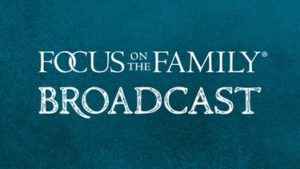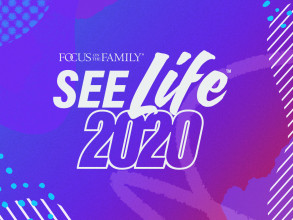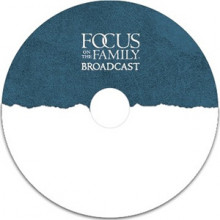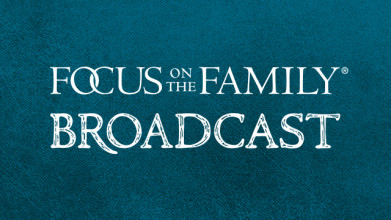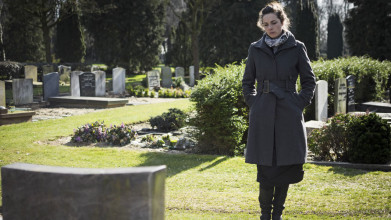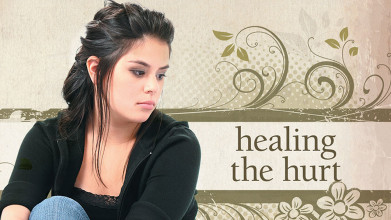John Fuller: So, let me ask you to take a second and look at your right hand and hold your index finger and your thumb about an inch apart and consider: you were once that small. Even when you were that small, you were perfectly made, and you were seen and loved by God. Now that realization has changed one man’s life forever and you’re going to hear his powerful story today on Focus on the Family. Your host is Focus president and author, Jim Daly. And I’m John Fuller.
Jim Daly: John, it’s truly amazing to think of how detail-oriented God is. I mean, He holds the whole universe in His hands and still takes the time to carefully knit us all together – our fingernails, our ears, our eyes, our noses. That’s one of the reasons we’re going to feature a ultrasound of a pre-born baby in the third trimester this Saturday evening in the premiere of See Life 2020. This is the online version of what we did in Times Square last year when we showed an ultrasound of a baby on the big screens. That picture of a pre-born baby is really one of the best and most persuasive arguments for life.
John: It really is, and you can find out more about See Life 2020 which is our free, online event this Saturday, 8pm, eastern, by going to our website – focusonthefamily.com/broadcast. And, Jim, our guests today have a perspective of the pro-life movement that is really crucial for us to understand.
Jim: Yeah, it’s true and today we’re going to share a powerful conversation that we had with a doctor who used to perform abortions, thousands of them, and I can guarantee you won’t be able to listen to his story without being impacted and reminded of the amazing grace we all are offered through Jesus.
John: And his name is Anthony Levatino and his wife, Cecelia, joined us in the studio as well. And Dr. Levatino has 40 years’ experience as an OB-GYN, and Cecelia is a former medical professional, as well. And as we get into the content, there will be some tender and perhaps even graphic content in the broadcast, so, parents, you might want to use your earbuds for this one. Let’s go ahead and listen in now to the first of this two-part conversation on Focus on the Family.
Jim: Uh, Tony and Cecelia, welcome to Focus on the Family.
Mrs. Cecelia Levatino: Thank you.
Dr. Anthony Levatino: Thank you.
Cecelia: We’re thrilled to be here.
Jim: It’s so good to have you. Um, you two had similar childhoods, but you entered adulthood with, um, different beliefs about abortion. And, uh, describe what you believed, and, Tony, let’s just start with you.
Anthony: I graduated from medical school in 1976. And I didn’t know exactly what I was gonna do when I went to medical school. Um, my mother, who had six children, had always said, “Oh, maybe you’ll become a baby doctor.” And I said, “No way, Ma.”
Jim: (Laughter).
Anthony: And then…
Jim: Never say never.
Anthony: Yeah, never say never. When I did my third-year rotations as third year, my first one was in obstetrics and gynecology. And I learned pretty quickly that this was really great stuff. I really enjoyed doing this. It was only my first rotation, and I thought, “Well, I’ll like all my rotations.” Well, it turned out I didn’t. And different personalities go to different areas of medicine. And mine was – it was so much more fun saying, “It’s a boy”, “It’s a girl” rather than, “Oh, you know, your mom’s in bad shape. Maybe you better come to the hospital.”
Jim: Mmm.
Anthony: Um, so when I graduated in ’76, when – and had already picked OB-GYN as my specialty, if you would ask me how I felt about the abortion issue, I wouldn’t have hesitated for a second to tell you I was pro-choice. This was a decision between a woman, her doctor, and no one, including the baby’s father, had anything to say about it.
Jim: And you defended that?
Anthony: Absolutely.
Jim: Yeah.
Anthony: Absolutely.
Jim: So, Cecelia, you, uh, were in the medical profession as well? A nurse or…
Cecelia: Yes, I did renal transplants.
Jim: And in that context, uh, you had a different perspective. You didn’t think abortion was a good thing to do.
Cecelia: I didn’t. Uh, I remember very vividly, uh, abortion was legalized in New York state three years prior to Roe v. Wade. And I was in nurses training at the time. And our instructor came to us, the – a group of us who were going into our OB rotation – and said, “The hospital’s going to start performing abortions, and it’s up to you as a student to decide whether you want to learn how to assist.” And in my entire class, there was only one other nursing student besides myself who said, “Nope, not gonna do that.”
Jim: Right.
Cecelia: And…
Jim: But it took courage in that class to be one of two people to say, “No, not for me.” Did you get any pushback?
Cecelia: No, we really didn’t back then. I mean, this was 1971.
Jim: Right.
Cecelia: And, um, our instructors were very supportive of the fact that we had the right to make that decision.
Jim: Where was God for both of you? Just to paint the picture for the listener. I mean, you know, you’re a go-getter, ’70s doctor. You’re coming out of med school, OB-GYN. You’re the nurse. You guys meet, I’m assuming, in a medical environment. Did you – were you working at the same hospital?
Cecelia: Yeah, when he was an intern.
Jim: Okay.
Cecelia: He was doing, uh, a surgical rotation on the transplant floor, and that’s how we met.
Jim: And then spiritually, I mean, was there anything there? Uh, what – any – where was the Lord in your heart at that time or was it just – it just wasn’t a part of your life?
Cecelia: It – it wasn’t.
Anthony: Not at that time.
Cecelia: We had both walked away from the faith that we had been raised in. And, um, I think pretty much at that point, we would probably have categorized ourselves as agnostics.
Jim: Okay. And then you get married. And, again, you’re coming from different perspectives on this issue. Of course, you’re marrying a doctor who does OB-GYN. He’s also doing abortions at this time. How – how did you feel, Cecelia? I mean, did – did you ever bring it up around the dinner table?
Cecelia: (Laughter) No, it was not a topic of discussion. And it really didn’t become an issue until, um, we decided to start a family. And we were having an infertility problem, and I wasn’t getting pregnant.
Jim: Mmm.
Cecelia: And so, Tony sent me to the best infertility specialist in town. And, um, after a lot of tests and some surgeries and – and other experimental things, he – he said, “You know, there’s one more – there’s one more surgical procedure we can try. It’ll only take about an hour and a half.” And when he walked out of the OR 3 1/2 hours later, he looked at Tony and he said, “You know, I never say never, but don’t plan on having any children of your own.”
John: Mmm.
Jim: Huh.
Cecelia: We were devastated.
Jim: Yeah. And I want to pick up on that. But I want to continue to build kind of the environment you’re in. And we’re gonna come back to it and pick that part of the story up. Tony, you – uh, as a doctor, one of the things that I understand you’re taught, you have to somewhat distance yourself emotionally from your patient. Uh, sometimes you have to do things that are tough and grueling and all those things. But particularly in the abortion industry, you have to dehumanize the baby.
Anthony: You do.
Jim: Speak to that.
Anthony: You absolutely do. I mean, that – “dehumanization” is such a tough term, okay? But keeping, uh, an emotional distance from your patients is essential to our work. And there is – there is a certain professional distance that must be maintained professionally. On the other hand, that distance can get a little bit too far. And you’re right. And, you know, in terms of abortion, I’m just doing a medical procedure. I’m just helping this woman.
Jim: Right.
Anthony: Never stop for a minute…
Jim: And you’ve got to keep telling yourself.
Anthony: Well, you tell yourself that, but – and, you know, you say, “I’m – I’m not actually tearing babies apart.” But then again, at the end of even a suction DNC abortion, you have to – you do a suction machine. There’s a little stocking in there that collects parts. At the end of the procedure, you have to take that, open that up, empty it and literally take inventory to make sure that you got two arms, two legs and all the pieces.
Jim: Yeah.
Anthony: So, you tell yourself that day in and day out, but you’re faced with the reality of it every single procedure you do.
Jim: I think some people, Tony, hearing that, they – they can’t fathom how you could get that distant from humanity – that, you know, as you’re doing the DNC, which is cutting this baby apart – right? – and pulling the baby out piece by piece.
Anthony: I assure you, and I’m sure your audience realizes, you can get used to almost anything.
Jim: Boy…
Anthony: …If you do it enough.
Jim: Boy, that’s amazing. Um, the other side of this is the profit motivation. Uh, I’ve met with some people in Planned Parenthood, and they were bold enough to simply say to me, “Yeah, it’s the money. Abortion is very profitable.” Speak to that in what you experienced in your own practice when it came to the profit incentive.
Anthony: As – understand something, I was not running an abortion clinic. So, I was – all of the abortions that I’ve done in my career were part of a routine OB-GYN office like probably almost every woman in the audience has been to at one time or another. We did everything. We did hysterectomies. We did deliveries, and we did abortion. Now there’s a little bit of a different focus when you’re doing that. Um, if I’m running an abortion clinic and you come in and you change your mind, I don’t make any money that day. Um, in my office, we didn’t care.
Jim: Yeah.
Anthony: We really didn’t care. “You want to have an abortion? Great.” “You want to have your baby? Great.” Um, we were perfectly happy either way. On the other hand, obstetrics is a very high-risk specialty in terms of medical malpractice. It’s one of the – the – you know, it’s at the highest end of the malpractice, uh, uh, you know, hit parade along with neurosurgery and maybe orthopedics. Um, so there’s a lot of legal liability involved. And I could – at the time, I could do a delivery. I would see you eight or nine times during your pregnancy. Um, I would – you’d call me in the middle of the night. I’d show up in the hospital. I – sometimes I would wait for hours for the baby to be born. And for all of that effort, I made about $1,200, say average…
Jim: Huh.
Anthony: …At the time.
Jim: Yeah.
Anthony: Um, or I could do an abortion. I was – we were charging – for a first trimester abortion, we were charging maybe – and again, this was – this was early ’80s but, um, you know, $300 to maybe $500 depending on how far along you were. There was more if you were – if we were doing a second trimester abortion. That’s a whole ‘nother story.
Jim: Right.
Anthony: Um, but I could do an abortion in 15 minutes. If I did three abortions, I made just as much as I made with all those months of effort with the obstetrics. And, you know, I – I’m done in less than an hour, and I could be on the golf course, you know, in no time flat and face essentially no legal liability.
Jim: Yeah.
Anthony: Because, you know, things do happen to – during abortions…
Jim: Yeah.
Anthony: …But it was relatively rare to get a lawsuit because no woman wants to sit in a court of law and talk about her abortion.
Jim: Yeah. Tony, I mean, I am sure some listeners as they’re hearing you, you’re a doctor – you’re a medical professional – you’re even speaking of this very clinically, but it is what it is, right? This is…
Anthony: Absolutely.
Jim: …This is the business. This is the industry. This is what happens in that environment. Cecelia, I now want to come back to, uh, that opening that you gave me regarding your family desires, uh, where you were at. How long were you married when you wanted to start having children?
Anthony: Well, we…
Cecelia: Well, we kind of laugh…
(LAUGHTER)
Cecelia: We kind of laugh now. Um, I think I was 29 or something and – and, uh, we thought we were really old and needed to get started right away.
Jim: At 29?
Cecelia: (Laughter) At 29, yeah (laughter).
Jim: Yeah. There you go, Gen Xers.
(LAUGHTER)
Cecelia: Um, so we…
Anthony: But those days are long gone.
Jim: Yes.
Cecelia: Yeah. So, um – so we – we didn’t wait very long. We – he came from a family of six. I had two sisters. Um, we – having kids was part of what we saw, our future.
Jim: Sure.
Cecelia: So getting back to your original question, it wasn’t until I was going through the infertility that the fact that he was doing abortions started to impact me emotionally.
Jim: How – how – what did that connection feel like to you? Here you’re trying to get pregnant. Your husband’s doing abortions, taking the lives of babies. It is quite a contrast.
Cecelia: It was. And that’s exactly how I was processing it. Um, I can remember literally standing in the shower, just crying my eyes out. And – and even though we weren’t affiliated with any church or anything, I mean, I can remember vividly just…
Jim: Huh.
Cecelia: …Crying to God and saying, you know, “Here I am trying to have a baby. My husband is killing them. Please, Lord.”
Jim: Huh.
Cecelia: Uh, you know, it was very emotional. It was – because I – I knew what was going on.
Jim: Yeah, but some – I – I guess for some they wouldn’t necessarily make that connection. It’s amazing the Lord, you know, allowed you to see that contrast…
Cecelia: Yeah.
Jim: …And to feel it the way you felt it…
John: Mmm.
Jim: …Um, a lot of people would have gone right by that. You know, “That’s just what my husband does.” But you were still finding it difficult to talk to Tony about it, right?
Cecelia: Oh, yeah. We – we didn’t talk about it. We’ll get…
Jim: So, it was just off limits.
Cecelia: It was. It was off limits. I remember vividly bringing it up. We were out to dinner with, uh, a couple of other doctors and their wives and, um, and (laughter) foolishly saying something pro-life and one of the doctors went – I mean, he practically came over – the – the dinner table…
Jim: Mmm.
Cecelia: …And said, “What do you want to do? Go back to the days of – of coat hangers?”
Jim: Right.
Cecelia: It was like, “Whoa, okay.” You know, my husband’s just starting his practice. We…
Jim: Yeah.
Cecelia: …We can’t talk about these things.
Jim: Wow. It just puts you in the corner…
Cecelia: It really did…
Jim: …And locked the door.
Cecelia: …And – and I was totally intimidated by it.
Jim: Yeah.
John: Mmm. This is Focus on the Family with Jim Daly. And today our guests are Dr. Tony Levatino and his wife, Cecelia. And, uh, we would invite you to stop by our website for materials, for resources, for help if you are struggling with abortion, uh, in any way. Our number is 800, the letter A and the word FAMILY. Online we’re at focusonthefamily.com/broadcast.
Jim: Tony, as you’re pursuing the family and you’re going through infertility, uh, options, was there any kind of conflict for you? I mean, here, you’re trying to have a baby, and you’re taking the lives of other women’s babies.
Anthony: It was not a problem initially. I mean, Ceil was going, you know, through the whole infertility thing. Um, and when her doctor, you know, walked out, as I said, hours after this procedure had begun and said, you know, “I never say never, but don’t count on having a family of your own,” that’s when it first hit me. Ad very soon after that, as, you know, we – we decided, “Well, all right, if these are the cards we’ve been dealt, we’ll adopt a baby.” And anyone who’s tried to adopt a baby knows how difficult that is.
Jim: Sure. It’s a process.
Anthony: It’s – well, it’s incredibly difficult. And, you know, we went to state agencies, religious agencies, county agencies. The best we could do after months of effort was get on a five-year waiting list to get on the actual waiting list. And that was when I had my first doubts. I mean, they were strictly selfish. But it was, you know, “Here I am. I’m perfectly willing to take any child, you know, to love and care for as our own.” And that’s when I had my first doubts about it. I remember – I remember very distinctly a particular abortion – I can see the room – and doing a first trimester D and C abortion and – and you know, opening the machine and looking at the pieces and thinking, “Oh, my gosh. I’m throwing these kids in the garbage.”
Jim: Ah.
Anthony: You know, “Wouldn’t even one of these women allow us to take her baby home and care for as our own?” But, of course, it doesn’t work that way. So, that was the first doubts I had. They were very selfish, but that’s where the doubt crept in.
Jim: No, and I can imagine. However, uh, there came a moment in that adoption pursuit where someone became available. What – what were the details regarding that?
Cecelia: Um, Tony and I were talking about the adoption process one night. And, um – and he said, “You know, I know 52 OB-GYNs on a first-name basis. Why don’t we just start advertising?”
Jim: Just go to the doctors.
Cecelia: Just, call them. You see them…
Jim: Yeah.
Cecelia: …In the hospital, in the delivery room. Just let them know…
Jim: Right.
Cecelia: …We’re looking for a baby to adopt. And he did. And it wasn’t too long after that that he was in the OR one day and the circulating nurse tapped him on the back of the shoulder and held up a little piece of paper that said, “Call Marcia.” Marcia was the head of the human resources at the hospital. And, uh, when he was finished in the OR, he called her. And she told him that there was a 15-year-old girl, um, in labor and delivery, um, had had no prenatal care until the day before, but it looks like she – you know, her parents had taken good care of her, and – and the baby was gonna be a nice, healthy baby, and she was doing fine.
Jim: 15-years-old.
Cecelia: 15-years-old.
Jim: Wow.
Anthony: 15, yeah. She was in labor at the time.
Cecelia: And, um, so she said, “Are you interested?” And Tony said, “You bet.” And we were able to adopt our little girl named Heather.
Jim: Heather. And – and was it relatively easy or – at that point? I mean, the mother…
Cecelia: It was a private adopt…
Jim: …Was willing?
Cecelia: Oh, yeah.
Jim: Yeah.
Anthony: Absolutely.
Cecelia: She was willing to give – to, uh, release, uh, the baby for adoption, and, um, everything went very, very smoothly.
Jim: The – um, so often, I hear the story. So, a couple is deemed infertile. They seek adoption with all the heartache of that. You know, a baby’s available; it’s not available. And, uh, even at a foster care, you know, if you try to adopt through the foster care, which we, um, advocate – we have a program called Wait No More that helps couples consider adoption from foster care. But there’s no guarantee, uh, those kids come to you. The parents may not terminate their rights, or the courts may not totally terminate their rights. They fight. There’s all this heartache, is the point. And then especially for those couples that are infertile, boom, something happens. That happened to you. You got pregnant.
Cecelia: It sure – it sure did. Yeah.
(LAUGHTER)
Jim: Was that a joyful moment for you?
Cecelia: It was a shocking moment.
(LAUGHTER)
Jim: So you’ve adopted Heather.
Cecelia: We’ve adopted Heather.
Jim: And then how long…
Anthony: And a month later, she was pregnant.
Cecelia: A month later.
Jim: Within a year? A month.
Anthony: A month.
Cecelia: A month.
Jim: (Laughter).
Cecelia: A month.
Jim: That’s amazing.
Cecelia: We had two kids 10 months apart (laughter).
John: Yeah. Well, after the infertility ups and downs, I mean, there’s a lot of emotion wrapped up in that, so it must’ve been quite a jolt to your system to not just adopt but then find out you’re pregnant all within such a short space of time.
Cecelia: It was. It was, uh – it was pretty overwhelming at first. And, uh, I mean, it was wonderful, but it was overwhelming.
John: It was what you wanted. Yeah.
Cecelia: Exactly.
Jim: You know, back to the adoption – one thing in – in taking a look at that history that you have, um, you mentioned in speeches that you’ve given and other venues, one of the reasons people struggle with adoption is the number of abortions that are occurring eliminates, obviously, a pool of children where a loving home can be found for them. And that was part of your struggle, right?
Anthony: Oh, absolutely. I mean, I’m not an idiot. I knew why it was difficult to find children to adopt. You know, a big part of it was people like me doing abortions.
Jim: I mean, but connecting those dots, it just – the – for some reason, the culture struggles. The elites in the culture seem to struggle connecting those dots as you did, that, you know, when we eliminate children through abortion, there’s nobody for adoption.
Anthony: Um, that – I think that’s very much the case.
Jim: Yeah. That’s…
Anthony: I mean, I can just tell you, when you’re pro-choice and you are dedicated pro-choice, a lot of what might seem like obvious facts to other people aren’t so obvious to you.
Jim: Hmm. Right. So you have Heather. You’re pregnant with your son, right? And he’s born. Uh, what’s his name?
Cecelia: Sean Thomas.
Jim: So, Sean is born. And how are things going at this point? Now you have an adopted child, your naturally born child, and you’re still taking the lives of children. Any conflict for you guys at this point?
Anthony: Well, as said earlier, I mean, my conflict came when we were trying to adopt a child and were having so much difficulty. Now, all of a sudden, I have a son and a daughter. And any doubts I had about doing abortion simply evaporated, and I went back to business as usual.
John: Hmm.
Jim: Huh. That’s really something. And you just continued – no further conflict.
Anthony: None.
Jim: Spiritually, what was happening? Either of you kind of coming to greater awareness of God at that time?
Cecelia: Um, it took a couple of years, but there – there became a point when the kids were toddlers that I really wanted to start going back to church. I wanted them to have the experience of having a faith foundation. And so, uh, we joined a, um, Presbyterian church and started attending and getting involved and teaching Sunday school and all the things you do (laughter).
Anthony: Yeah. It was a PCUSA church, which, of course, under their creed, there was no – zero problem with my being an abortionist, so…
Jim: Yeah. And that was it. Now, uh, the tragedy – this is, you know, um, something we have to cover. But, um, Heather, after you adopted her and Sean is born, life’s going along pretty well.
Cecelia: Mm-hmm.
Jim: And then one day you experience something horrific. What happened?
Anthony: Um, June 23, 1984, was a beautiful day in Albany. It was a Saturday. I was on call, not very busy. I got – made rounds and got to spend the rest of the day with our kids. Uh, we took them to an amusement park that day. We had dinner together. And the kids were playing in the backyard when we had friends come over for cake and coffee. And we were speaking with our friends, and at 7:25 that night, we heard the screech of brakes out in front of the house and, um, ran out and found out that the kids had gone in the road and Heather had been hit by a car. She was a mess. Um…
Jim: And you ran out to find her.
Anthony: Yeah. Well, I’m a doctor. I’m supposed be able to save people’s lives. My wife was an intensive care nurse. I mean, this was our living. Um, we did, obviously, what we could, but it made no difference, and she literally died in our arms in the back of an ambulance.
John: Hmm.
Jim: That is a tragic moment. I mean, I’m sure some parents have experienced something similar. And it’s hard to even talk about it. I mean, all these years later, the tears are there in your eyes and…
Anthony: Yeah. She was exactly two months away from her 6th birthday at the time.
Jim: Yeah. When you – when you feel that, when you go through something like that tragic loss, um, how did you cope?
Anthony: Hmm.
(PAUSE)
Jim: Especially being who you are as a doctor?
Anthony: Well, I wasn’t even thinking of it in terms of the abortion industry or what I was doing. Um, anyone in the audience that has kids may think they have some – they know how much they love their children, and they may think they have some idea of what it’s like to go through that. And I promise everyone that if you haven’t been through this yourself, you have no clue.
Jim: Yeah.
Anthony: And I hope you never, ever find out.
Jim: Yeah.
Anthony: Um, you know, what do you do? I mean, the problem for us as a couple was that, you know, as Ceil talked about earlier, we made a decision early on in our relationship that this was a – you know, a forbidden topic. The problem – when a couple stops talking about one important topic, they suddenly may find out that it’s a lot easier to stop talking about other important topics as well. It becomes just something you do. And we’d been drifting apart, um, in more than one way.
Jim: Sure.
Anthony: And it didn’t really hit me until – and we were almost literally mourning apart. Uh, it was incredibly difficult. It’s almost impossible to describe.
Jim: Yeah.
Anthony: But it didn’t hit me till – I don’t know how long it was after Heather died. It was just a few weeks. Uh, you know, what do you do? You bury your child. You take some time off. Then you try to get back in your life. Um, and it was just a few weeks after her death, and I showed up at OR No. 9 at Albany Medical Center, and I was doing second-trimester abortions up to 24 weeks at the time. Um, and I arrived at the hospital to do a second-trimester D&E abortion. And these are absolutely gruesome procedures. I mean, because you’re not talking about a baby an inch long anymore.
Jim: Right.
Anthony: A 20-week baby is the length of your hand, from the tip of your middle finger to your wrist. That’s head to rump 20 weeks, not counting the legs. And you’re tearing these kids apart literally bit by bit with the instruments. Um, and I wasn’t even thinking of this as anything special. This was routine. I obviously had other things on my mind.
Jim: Yeah.
Anthony: So, I went in, and I started the abortion, and I literally ripped out an arm or leg…
Jim: Hmm.
Anthony: …As I had over a hundred times before in second-trimester abortions. And I just stared at it in the clamp, and I got sick. Um, but when you start an abortion, you can’t stop. I’d said earlier, you have to keep inventory. You have to make sure that you get two arms, two legs and all the pieces because if you don’t, your patient will come back infected, bleeding, or dead. So, I finished the abortion, and now we’re talking a big baby here, not some little tiny one. Um, and you literally stack parts on the side of the table so you can keep inventory.
Jim: Mm.
Anthony: And for the first time in my career – and I know it sounds strange to people, but we always promise telling people that everything we’re saying is firsthand and true. For the first time, I looked. I mean, I really, really looked at that pile of body parts. And I didn’t see her wonderful right to choose, and I didn’t see what a great doctor I was helping her out, and I didn’t even see the $800 cash I just made in 15 minutes. All I could see was somebody’s son or daughter.
John: Hmm.
Jim: Wow.
Anthony: And it occurred to me in that instant, you know, that this patient had come to me figuratively – never literally – and said, “Here’s $800. Kill my son or daughter.” And I was the kind of person that would look her right in the eye and with no compunction whatsoever, say, “Sure. I’ll do that.”
Jim: Yeah. I mean, Tony, that’s a heavy burden to carry. And we’re right at the end of the program today, but I do want to come back next time, pick up the discussion. Cecelia, I want to hear your heart as mom going through that tragedy with Heather and the loss of her life just before her 6th birthday. So, can we do that? Can you come back? And we’ll continue.
Cecelia: Absolutely.
Jim: Let’s do that.
John: Well, we’ve covered some really heavy ground today and some difficult topics on Focus on the Family. And I’d like to remind you that we have caring, Christian counselors on staff here and it would be our privilege to schedule a time for them to talk with you, completely free of charge. And, um, you can just call 800, the letter A and the word FAMILY and request that service. Or, we have a counseling request form at focusonthefamily.com/broadcast. And I do also want to let you know about our Option Ultrasound. We’ve talked about it a number of times here on the broadcast. It’s our ministry to women with unplanned pregnancies who are considering an abortion. We’ve got the statistics and research and $60 saves a baby’s life through Option Ultrasound. You can join that support team and save a life, literally, by giving us a call or donating at the website. On behalf of Jim Daly and the entire team, thanks for joining us today for Focus on the Family. I’m John Fuller, inviting you back as we continue the conversation with our guests and once more help you and your family thrive in Christ.
